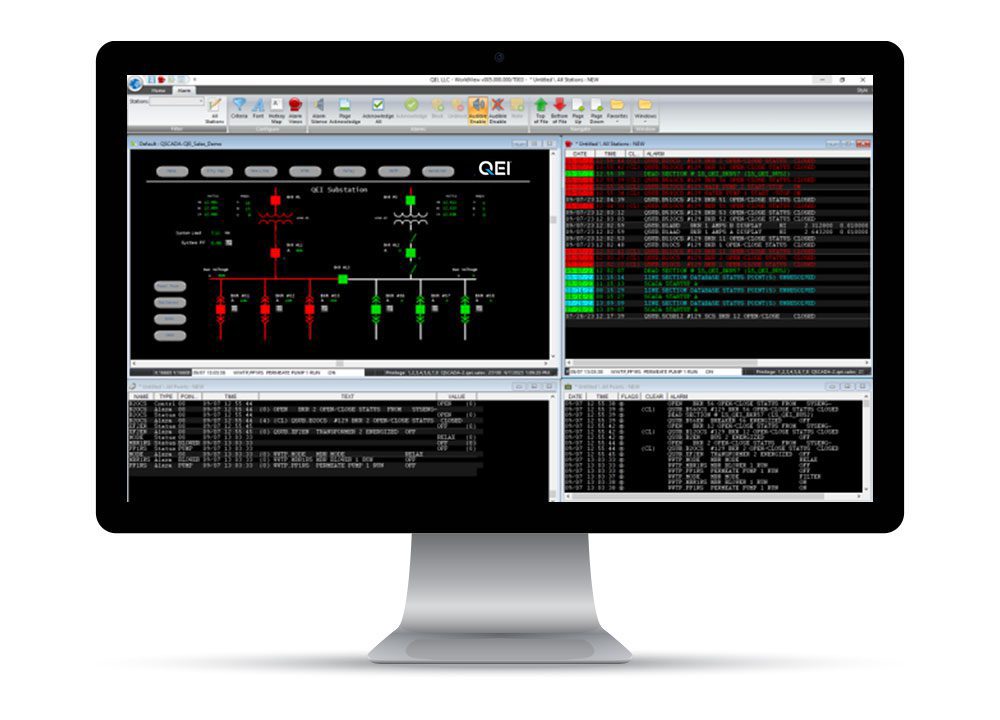
What is Volt-Var Optimization & Why Does It Matter for Utilities?
As utilities modernize their power grids, Volt-Var Optimization (VVO) has become a critical tool for improving grid efficiency, reducing energy losses, and enhancing voltage stability. By optimizing voltage and reactive power (VAR) levels, utilities can lower operational costs, improve power quality, and support renewable energy integration.
One of the most effective ways to implement VVO is through advanced SCADA systems like QEI’s QSCADA. Let’s take a closer look at what Volt-Var Optimization is and why it matters for today’s utilities.
What is Volt-Var Optimization?
Volt-Var Optimization is the process of controlling voltage levels and reactive power across an electrical distribution network. This ensures that voltage remains within an optimal range while minimizing energy losses.
The key components of a VVO system include:
- Voltage Regulators & Load Tap Changers (LTCs): Adjust voltage levels to maintain stability.
- Capacitor Banks: Provide reactive power to improve power factor.
- SCADA & Automation Systems: Monitor, analyze, and automate voltage and VAR adjustments in real time.
By coordinating these devices, utilities can optimize energy delivery, reduce excess power usage, and improve overall grid performance.
Why Does Volt-Var Optimization Matter for Utilities?
- Reduces Energy Losses & Lowers Costs
One of the biggest challenges utilities face is line losses, where electricity is wasted due to the impedance of power lines. By optimizing voltage and reactive power, VVO minimizes these losses, leading to:
- Lower operational costs
- More efficient energy delivery
- Reduced wear on grid equipment
With QSCADA, utilities can automate voltage adjustments in real time, ensuring the system operates at peak efficiency.
Utilities often observe energy savings ranging from 1% to 4% upon initial deployment of VVO systems.
- Improves Power Quality & Grid Stability
Voltage fluctuations can cause:
- Equipment malfunctions
- Power inefficiencies
- Customer complaints
VVO helps utilities maintain consistent voltage levels, reducing power disruptions and enhancing service reliability. QSCADA’s advanced monitoring tools allow operators to detect and correct voltage variations instantly.
- Reduces Peak Demand & Enhances Energy Savings
Many utilities implement Volt-Var Optimization as part of Conservation Voltage Reduction (CVR) strategies, which reduce voltage levels slightly during peak hours to decrease overall power demand.
By leveraging QSCADA’s automated controls, utilities can:
- Reduce peak energy consumption
- Lower electricity costs for consumers
- Extend the lifespan of grid infrastructure
- Automates Grid Operations for Maximum Efficiency
Traditional voltage control relied on manual adjustments, which were slow and inefficient. With modern SCADA systems like QSCADA, utilities can:
- Monitor the grid in real-time
- Automate voltage and VAR adjustments
- Improve decision-making with advanced analytics
This automation not only improves reliability but also reduces labor costs and human error in grid management.
How QEI’s QSCADA Enhances Volt-Var Optimization
QSCADA, QEI’s advanced Supervisory Control and Data Acquisition (SCADA) system, is designed to help utilities monitor, analyze, and optimize Volt-Var operations with:
- Real-time voltage and VAR monitoring
- Automated capacitor bank and voltage regulator control
- Seamless DER and renewable energy integration
- Data-driven insights for grid optimization
QSCADA Volt-VAR Optimizer: A Flexible, Automated Solution
QEI’s QSCADA Volt-VAR Optimizer extends these capabilities by providing utilities with a flexible and automated system for:
- Load Shedding & Voltage Regulation– Shifts power consumption from peak to non-peak periods, eliminating peak penalties while maintaining energy availability. The system monitors demand and automatically adjusts voltage regulators and load shed switches as needed.
- Power Factor Control– Ensures optimal system efficiency by monitoring and automatically correcting power factor levels across the distribution network, activating capacitor banks or load management switches when necessary.
- Voltage Optimization– Monitors voltage profiles at feeder and substation levels, using capacitor banks and voltage regulators to maintain optimal voltage levels and enable Conservation Voltage Reduction (CVR) for energy savings.
- Load Forecasting– Generates short-term (24-hour) and long-term (7-day) demand forecasts, helping utilities plan peak load deferral strategies and supply commitments.
- SCADA System Integration– The Volt-VAR Optimizer can be added to existing SCADA systems, supporting real-time data acquisition from AMI, DNP3, and Multispeak®-connected systems, among others.
With QSCADA and the Volt-VAR Optimizer, utilities can achieve greater accuracy, efficiency, and automation in voltage regulation and reactive power management, reducing energy losses, enhancing grid stability, and optimizing operational costs.
Volt-Var Optimization is no longer just an option—it’s a necessity for modern utilities looking to reduce costs, improve efficiency, and enhance grid reliability. With solutions like QEI’s QSCADA, utilities can take control of their voltage regulation and reactive power management, ensuring a smarter, more resilient power grid.
Want to learn more about how QSCADA can improve your Volt-Var Optimization strategy? Contact QEI today for more details.
Sources:
Determining the impacts of volt/VAR optimization: a tale of two approaches – Factor ThisTM (no date). Available at: https://www.renewableenergyworld.com/power-grid/transmission/determining-the-impacts-of-volt-var-optimization-a-tale-of-two-approaches
Volt/VAR Optimization | PNNL (no date). Available at: https://www.pnnl.gov/available-technologies/voltvar-optimization
Volt/VAR Optimization Reduces Losses, Peak Demands (no date). Available at: https://electricenergyonline.com/energy/magazine/466/article/Volt-VAR-Optimization-Reduces-Losses-Peak-




